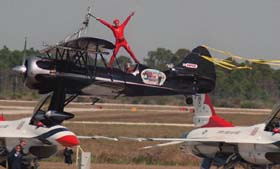| Tue, October 24, 2006 | |
|
|
Florida International Air Show Editor's Note: The following story is about the 1999 air 
Six USAF Thunderbirds pilots took to the air Saturday, March 24, for the Florida International Air Show at Charlotte County Airport in Punta Gorda. Meanwhile, a support contingent of more than 130 was on the ground, completing the team. The 12 officers and enlisted personnel come from more than 25 career fields. "We take people from all over the Air Force," said Maj. Scott Cerilli, who flies the number two position as left wing in the diamond formation. A couple of hours before the show, Cerilli was in the airport meeting room shining his boots to a mirror gloss. Yes, he affirmed, even the commander, Lt. Col. Ronald Mumm, shines his own footwear. It is Cerilli's first year with the U.S. Air Force Air Demonstration Squadron Thunderbirds. The officers serve only two years with the squadron while the enlisted persons serve three or four. Next year, there will be three new pilots.
The application is a six-month process of passing from one test to the next. When Cerilli applied, there were 55 qualified applicants for two slots. "It's very competitive," he said. "To be qualified, you must have a minimum of 1,000 hours of jet flying time and not more than 12 years of active service." Although two female officers are in the team, none is a pilot, yet. Cerilli said the Air Force had its first woman pilot only two years ago, and it takes a long time to accumulate 1,000 hours. The mission of the Thunderbirds is public relations, showing what the Air Force does and recruiting. In each town, they go to schools and speak to students. For this trip, three doctors applying for a position with the squadron came along to see how the team operates. One of the certified flight surgeons is Dr. John Hardy of Cannon Air Force Base in Clovis, N.M. "It's a lot of fun to take care of these guys, the best pilots in the Air Force," he said. "For a person in my position, it would be an honor to do that." Before the team arrived in Punta Gorda, the "advance pilot" flew over the airport with his crew chief. They must look for foreign objects that could damage the planes.
"There are things that might not affect a Cessna, but if such an object is sucked in the jet engine, it can ruin it," Cerilli said. Staff Sgt. Edward Teninty is in maintenance operations. He said the ground crew of 45 to 55 people flies in a C141, also transporting 50,000 pounds of equipment, depending on how long they will be gone. For each show site, the Thunderbirds leave Nellis Air Force Base in Las Vegas on Thursday morning. Friday, they prepare the planes for practice and do public relations functions - such as taking media representatives and VIPs for rides. Saturday and Sunday are demonstration days. However, the number one job is to recruit personnel. "The Air Force looks for highly motivated, dedicated people who want to be in the military," Teninty said. "And if they are interested in the military, we can direct them to the Air Force. There are many career fields in the Air Force." When they leave Punta Gorda, the Thunderbirds will go home to Las Vegas for the Easter break. Then they'll return to Florida for a demonstration April 13 and 14 at MacDill Air Force Base in St. Petersburg. The Thunderbirds travel more than 200 days each year, making no more than 88 demonstrations. Since they first performed in 1953, the team has never canceled a show because of maintenance. They are even prepared for uncooperative weather conditions with three different performances. In a beautiful blue sky, they do the "High Show." This is when they perform many loops at high altitude, Cerilli said. With a lower ceiling, they present the "Low Show." They do lots of rolls and the solos can still do maneuvers. The "Flat Show" is more restricted, Cerilli said. The performance needs a minimum of 2,000-foot ceiling and a five-mile visibility. Whatever the weather, one thing is never neglected -- the shine of the boots. After polishing his boot for nearly half an hour, Cerilli said: "If I go a couple of days without shining them, it takes me an hour and a half the next time." |
 © 2006
All rights reserved.
© 2006
All rights reserved.
Your Local Internet Service Provider
A division of Sun Coast Media Group Inc.
Publishers of the Sun newspapers.